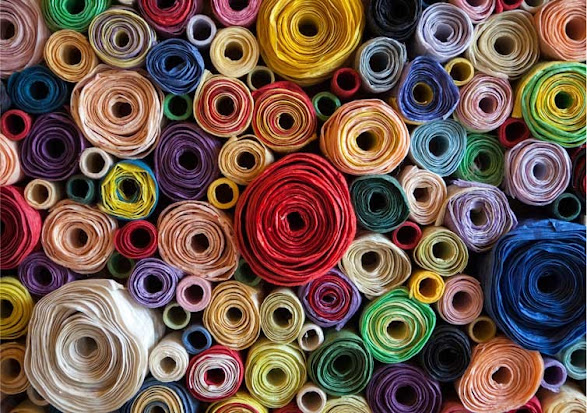''' '' FASHION INDUSTRY
FASTENS '' '''
THE FASHION INDUSTRY - INCLUDING CLOTHING, LEATHER AND FOOTWEAR - has long been under pressure to address the environmental effects of its products and practices.
The industry is responsible for 8 to 10 percent of the world's emissions of planet-warming carbon dioxide, the United Nations estimates, more than all international flights and maritime shipping combined.
Natural materials, like cotton, have their own environmental costs, of course. Cultivation of cotton and silk is water-intensive and can involve heavy pesticide use.
Some leather comes from well-managed ranches, but some can be tied to activities that are extremely damaging to the environment. Last year, a New York Times investigation showed how leather from the cattle linked to deforestation in the Amazon has made its way to the United States to be used in automobile seats.
The production of polyester and other materials has tripled since 2000, to nearly 60 million ton a year, according to the Textile Exchange, an industry group. Silk and wool have declined over the same period, and cotton has risen more moderately.
THE WORLD'S FASHION GIANTS SELL PLASTIC AS EARTH-FRIENDLY. Materials from fossil fuels, like ' vegan leather, ' rated as environmentally sound.
So, as the story goes : It's soft. It's labeled vegan. It looks just like leather. And it's also made from fossil fuels.
An explosion in the use of inexpensive, petroleum-based materials has transformed the fashion industry.
The growth has been aided by the successful rebranding of synthetic materials like plastic leather [once less flatteringly referred to as ''pleather''] with hip labels like ''vegan leather'' a marketing masterstroke meant to suggest environmental virtue.
Underlying that effort has been an influential rating system assessing the environmental impacts of all sorts of fabrics and materials. Named the Higg Index, the system was introduced in 2011 by some of the world's largest fashion brands and retailers, led by Walmart and Patagonia.
It was designed to measure and ultimately help reduce the brands' environmental footprints by cutting down on the amount of water used to to produce the clothes and shoes they sold, for example, or by reining in their use of harmful chemicals.
But the Higg Index strongly favors synthetic materials made from fossil fuels over the natural ones like cotton, wool or leather. Now those ratings are coming under fire from independent experts, as well as representatives of natural-fiber industries.
They say the Higgs Index is being used to portray the increasing use of synthetics as environmentally desirable, despite questions about synthetics' environmental toll.
''The index is justifying the choices fashion companies are making by portraying these synthetics as the most sustainable choice,'' said Veronica Bates Kassatly, a fashion industry analyst and critic of the industry's sustainability claims. ''They're saying : You can still shop till you drop, because everything is now so sustainably sourced.''
The Sustainable Apparel Coalition, which runs the index and counts among its members almost 150 brands, including H&M and Nike, as well as retail giants like Amazon and Target, said the index uses data that is scientifically and externally reviewed.
''This is years of work to compile and put together the best available, most up-to-date data,'' said Jermy Lardeau, vice president of the Higg Index at the apparel coalition. ''We are actively pushing for the synthetic numbers to be low. We're just collecting the data in one place.''
Critics counter that some of the data underpinning the index comes from research funded by the synthetic industry and not fully opened up to independent examination. Studies incorporated into the Higg Index are sometimes relatively narrow in scope, raising questions about their broad, industry-wide applicability.
The index rates polyester as one of the world's most sustainable fabrics, for example, using data on European polyester production provided by a plastics industry group. But most of the world's polyester is made in Asia, usually using a dirtier energy grid and under less stringent environment.
The Higg rating for eleastane, also known as Lycra or spandex, draws on a study by the world's largest elastane producer, Invista, a subsidiary of the conglomerate Koch Industries.
The Higg Index itself was born amid a growing emphasis among consumers on sustainability and environmental and animal-welfare concerns.
It coincided with advances in synthetic based fabrics that were not only inexpensive but had new features that buyers craved, such as improved elasticity or improvements in the ability to wick away perspiration.
The Honour and Serving of the Latest Global Operational Research on Fashion Industry, Plastics and Clothings, continues. The World Students Society thanks author Hiroko Tabuchi.
With respectful dedication to the Fashion Industry, and then Students, Professors and Teachers of the world. See Ya all prepare and register for Great Global Elections on The World Students Society - for every subject in the world : wssciw.blogspot.com and Twitter - !E-WOW! - The Ecosystem 2011 :
Good Night and God Bless
SAM Daily Times - the Voice of the Voiceless

.png)


0 comments:
Post a Comment
Grace A Comment!